Spanish Fencing – The Atajo
What is an Atajo? To understand the Atajo it is useful to understand the primary causes that make it work.
I’m intentionally going to present this from the perspective of a Pachequista (a follower of don Luis Pacheco). Pacheco literally defined the fencing master’s examination in Spain so in this regard his work is “canonical”.
The Advantage of Downward Pressure
If I extend my arm out toward you with the palm up and you press down while I resist you will probably be able to lower my arm. The Spanish call this the superior nature of the natural movement (descending) versus the violent movement (rising). Your own body also provides an advantage when you use your shoulder and body to assist in the motion to increase the downward force.
Principle: If all other factors are equal a downward force will defeat an upwards resistance.
The Advantage of Degrees of Strength
I have already written an article about blade mechanics, but every swordsman worth his or her salt should already know that in contact between two weapons, the swordsman with superior degrees of strength in the engagement has an advantage of power both offensively and defensively.
Principle: When two swords oppose each other in an engagement, the weapon with greater degrees of strength is stronger and has an advantage.
For more on strength in engagements consider this article:
Spanish Fencing Notation 5 – Strength of the Weapon
The Advantage of Time
When two adversaries act against each other the swordsman who can finish execution sooner has an advantage in time. The Spanish use Movements as a tool for understanding time. When the adversary’s attack requires three movements, he can be defeated by a defense or counteroffense which uses a single movement. In addition an engagement that completely closes a line can limit the adversary’s offensive options to ensure that the time advantage is maintained.
Principle: A defensive action that requires a single movement can defeat an offensive action with more movements.
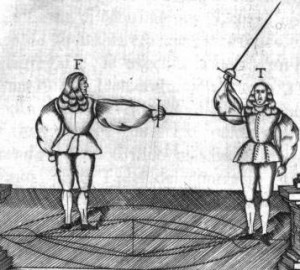
When the adversary attempts to strike with a circular reverse (3 movements) the defender answers with a thrust (1 movement). (Ettenhard Plate 11)
Principle: An engagement which prevents the adversary from attacking in a single motion provides a defensive advantage.
For more on Spanish Movements consider this article:
Spanish Fencing Notation 1 – Vector Notation
Advantage by Domination of the Shortest Path
The Spanish fencer starts with the arm extended and the weapon pointed at the adversary along the most direct path to the target. Knowing that it is easier to push downward then to resist upward, I can use this principle to deny my adversary the shortest path to my body by pushing his blade down. Not only do I increase the distance he must travel to strike my body, I also ensure that my offensive path is shorter and closer to the target.
Principle: By starting with the arm extended along the shortest path to the adversary and then deviating the adversary’s weapon downward you ensure your own path to the target is shorter.
Note: Deviating the opposing steel laterally would be called a desvio or a deflection.
Atajo Defined
The Spanish Atajo unites all of these ideas into a single defensive action which can protect the swordsman while simultaneously providing opportunities and the place from which to strike with safety. Offensively, the atajo can be used to prepare a safe attack that controls the adversary’s weapon. (We would call this preparatory action “dispositive” and the attack “executive“.)
Pacheco in New Science p.365 (1632)
| “Atajo, according to our definition, is when one of the weapons is placed over the other (not in any of its extremes nor with any of its extremes) and with equal or some degree more of strength subjects it and makes it so that the technique that can be formed must be done with more movements and the participation of more angles than those that its simple nature requires.” |
~Translated by Mary Curtis
Pacheco in New Science p.368 (1632)
| “Arriving, then, to the perfect formation of the atajo, it should necessarily consist of three movements: violent, offline lateral and natural. With the first the sword that should subject is placed on a superior plane to the other, with the second it is placed transversal over it, and with the last it subjects it:” |
~Translated by Mary Curtis
Ettenhard in his Compendium and Foundations… p.154-155 (1675)
| “I am very safely confident that one will have recognized with enough satisfaction that the Atajo causes its effects by means of a superior graduation and of the superior power of the Natural Movement and also that one will concede to me that if it were possible to beat and destroy these two causes, we would see dispelled the end of such superior effects…” |
~Translated by Mary Curtis
The Defining Elements of Atajo
Between Pacheco and Ettenhard we find these three items essential in placing Atajo:
- Subjection with equal or greater degrees of strength.
- The subjection is placed from above.
- The subjected line is closed so that an adversary cannot strike with a single movement.
When Lorenz de Rada writes later, he adapts the atajo so that you initially seek the subjection from above and if you don’t find it or feel that the adversary is weak in the engagement you immediately spiral towards the opposing steel and closing the opposite line from below. Compare this to the classical transports of 3rd and 4th from high to low or the corresponding half-circular parries from high to low.
Conclusion
This information tells us that Pacheco’s Atajo should start by seeking the superior line with greater degrees of strength in the weapon. The defensive action subjects downward to lengthen the adversary’s path to the target while ensuring your own path is shorter. It might be tempting to equate Atajo with classical engagements but this violates the primary causes of Atajo. Likewise, by definition two swordsmen cannot both have an Atajo simultaneously.


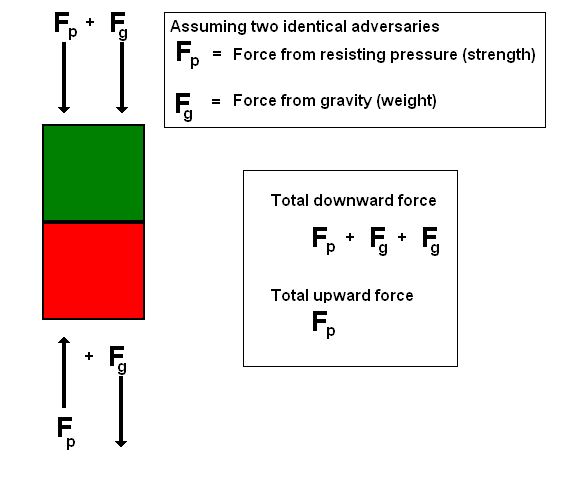
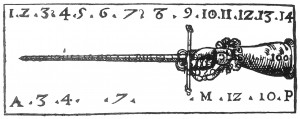
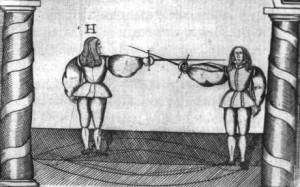
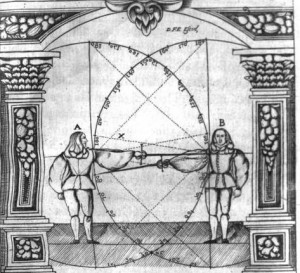
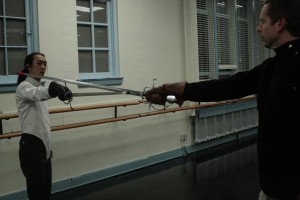
What do you think?
You must be logged in to comment.